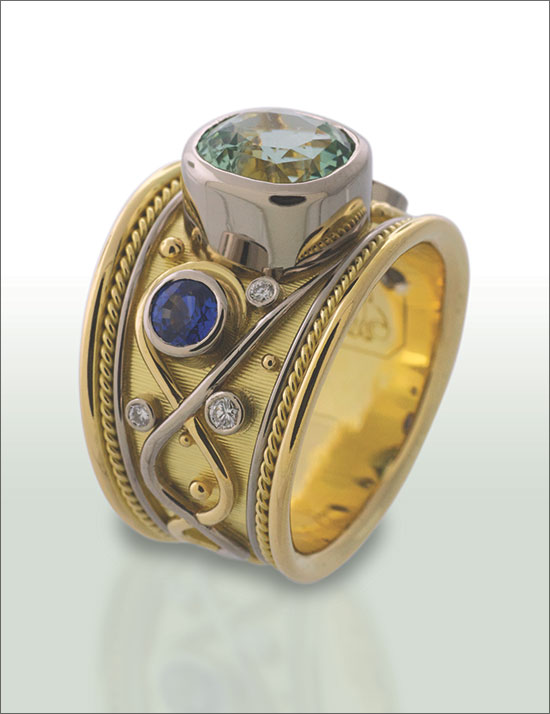Renaissance Ring by Andrew Costen
Known for his contemporary designs, Andrew Costen of Costen Catbalue in Vancouver, British Columbia, Canada, enjoys occasionally returning to his roots to create what he calls a Renaissance ring, this one in 18k white and yellow gold and set with an aquamarine, sapphires, and diamonds.
 Costen begins by alloying 18k yellow gold and forming sheet that he rolls to 0.8 mm for the ring's shank. "It naturally wants to concave a bit, so I use a planishing hammer on the center of the metal all the way around, not getting too close to the edges because it will make it bigger," says Costen. "This brings the ring up very slightly convex.".
2 Minute Read
Known for his contemporary designs, Andrew Costen of Costen Catbalue in Vancouver, British Columbia, Canada, enjoys occasionally returning to his roots to create what he calls the Renaissance Ring, this one in 18k white and yellow gold and set with an aquamarine, sapphires, and diamonds.
Renaissance Ring
Costen begins by alloying 18k yellow gold and forming sheet that he rolls to 0.8 mm for the Renaissance ring's shank. "It naturally wants to concave a bit, so I use a planishing hammer on the center of the metal all the way around, not getting too close to the edges because it will make it bigger," says Costen. "This brings the ring up very slightly convex."
Once shaped around a mandrel, he solders it with hard solder, then tapers the band so it will be comfortable.
After annealing, Costen uses a Florentine engraving tool to create the texture in the shank. He takes care to apply even pressure when working around the perimeter of the shank. He then forms the three bands that frame the shank-7 mm 18k smooth white wire, 4 mm 18k twisted yellow gold wire, and 1.2 mm smooth yellow gold wire-and solders them into place.
With the canvas ready, Costen proceeds with his painterly touches, fabricating bezels for the three largest stones from 18k white gold tubing and attaching them to the shank with medium solder. He positions the sapphire bezels to leave room on the canvas for decorative wires.
After filing a length of 0.9 mm yellow gold wire to a point and polishing it, he bends it to fit around one sapphire's bezel and tacks it down at about the first millimeter, allowing the molten solder to jump onto the wire before he brings it down to the ring. Guided by a sketch of the wirework he envisions, Costen gently heats the wire to anneal it and applies slight pressure with spring tweezers to shape it. He then pushes it toward the ring in about 4 mm sections, being careful not to squeeze too tightly and break the wire.
Once positioned, he solders the wire completely to the base and repeats the process with a slightly thicker 1 mm white gold wire. Costen uses a ball bur to cut out the section of yellow gold wire where the two wires intersect to ensure a tight fit.
The wire and bezel-set stones serve two purposes-decoration and protection for the engraved background. "Similar rings I made 30 years ago still look clean," Costen says. He artistically arranges handmade granules and pre-set diamonds to complete the design, soldering the granules and drilling holes into the ring where he wants to place the diamonds. He pushes them up or down in the hole to the level he wants, then solders from the reverse.
As a finishing touch, he fills the gap between the ring shank and the yellow gold outer band with medium solder to make it appear as one piece, filing the edge to complete the look. After setting the 2.6 carat aquamarine and the other 0.21 carat blue sapphires, Costen polishes the wires and bezels but retains the natural matte finish on the 18k shank. The picture is complete.
Some customers consider these rings Celtic, some medieval, but all agree they have a look of antiquity-a tribute to Costen's traditional English apprenticeship. "This is a class design with an old-world look," says Costen. "These rings are regal."
The award-winning Journal is published monthly by MJSA, the trade association for professional jewelry makers, designers, and related suppliers. It offers design ideas, fabrication and production techniques, bench tips, business and marketing insights, and trend and technology updates—the information crucial for business success. “More than other publications, MJSA Journal is oriented toward people like me: those trying to earn a living by designing and making jewelry,” says Jim Binnion of James Binnion Metal Arts.
Click here to read our latest articles
Click here to get a FREE four-month trial subscription.
You assume all responsibility and risk for the use of the safety resources available on or through this web page. The International Gem Society LLC does not assume any liability for the materials, information and opinions provided on, or available through, this web page. No advice or information provided by this website shall create any warranty. Reliance on such advice, information or the content of this web page is solely at your own risk, including without limitation any safety guidelines, resources or precautions, or any other information related to safety that may be available on or through this web page. The International Gem Society LLC disclaims any liability for injury, death or damages resulting from the use thereof.
The All-In-One Jewelry Making Solution At Your Fingertips
When you join the Ganoksin community, you get the tools you need to take your work to the next level.
Trusted Jewelry Making Information & Techniques
Sign up to receive the latest articles, techniques, and inspirations with our free newsletter.
